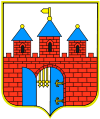Obrońców Bydgoszczy street in Bydgoszcz
Obrońców Bydgoszczy street is located in downtown district, in Bydgoszcz, Poland. Many of the buildings along this axis are either registered on the Kuyavian-Pomeranian Voivodeship heritage list, or part of a historical ensemble of Eclectic and Art Nouveau architecture in the city.
| Bydgoszcz | |
|---|---|
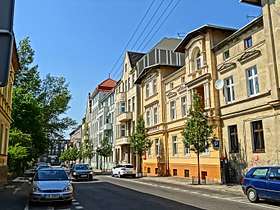 View of street facades | |
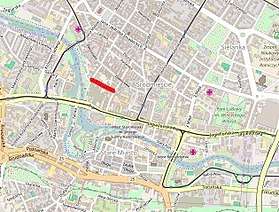 Obrońców Bydgoszczy street on a Bydgoszcz map | |
| Native name | Polish: Ulica Obrońców Bydgoszczy |
| Former name(s) | Peterson Straße |
| Namesake | The defenders of Bydgoszcz |
| Owner | City of Bydgoszcz |
| Length | 200 mGoogle maps (700 ft) |
| Width | ca. 10m |
| Area | Downtown district |
| Location | Bydgoszcz |
| Construction | |
| Construction start | 1884 |
| Completion | End of 1880s[1] |
Location
Located in downtown district, the street unfolds on an approximate south east - north west axis, parallel to Dworcowa Street, from Warmińskiego street on the east to Marcinkowskiego street on its western tip.
History
The first map of the city that references the street was issued at the outbreak of First World War:[2] the path appears under the name Petersonstraße.
Nevertheless, the 1884 issue of Bromberg's Adressbuch mentions the street, albeit with only two registered names[3]
Naming
The pathway, initially known as Petersohnstraße, has kept this naming after the re-creation of the Polish state in 1920, as Ulica Petersona.
Even during German occupation (1939-1945), the axis preserved this calling.
At the end of WWII, the street name changed to Ulica Trzeciego Września (Street of the 3rd of September), in reference to Bydgoszcz's Bloody Sunday events of 1939.[4]
The current namesake, Obrońców Bydgoszczy (transl. Defenders of Bydgoszcz), commemorates all the heroes who defended the city during the Second World War.
Main edifices
Tenement house at No.1, corner with Emila Warmińskiego Street
1884-1885[5]
The building has been one of the first erected in the street under Prussian rule, initially to house a private high school for girls (German: Höhere Töchterschule), then registered at Gammstraße 9.[6] In the 1910s, the school received the namesake of (Margarete) Dreger, one of its headmistress and was later called Dregersche Schule.[7] After the re-creation of the Polish state, the private high school kept working, for girls and boys, under the same appellation: Priwatne Liceum im. Drögera.[8] After the Second World War, the edifice lodged municipal Psychological and Pedagogical establishment No.1 (Polish: Poradnia Psychologiczno-Pedagogiczna). The institution moved out in the 2010s, and the ensemble has been proposed for selling to private owners by the city authorities in 2017.[9]
The edifice comprises three buildings displaying various styles, the lowest one being the former school gymnasium. The tenement standing at street corner has the most elaborated facades, with eclectic features: sleek bossage on the ground floor, windows topped by heavy lintels on the first floor and triangular pediments on the second, belt courses separating each level and a simple corbel table crowning the elevation.
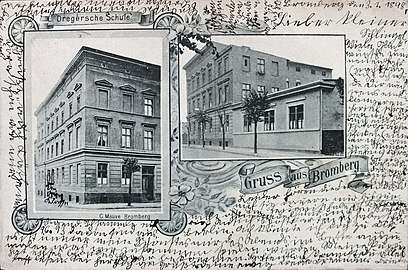 Postcard picture of the school ca 1898
Postcard picture of the school ca 1898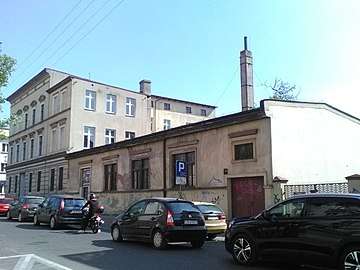 Frontages on the street, with the former gymnasium on the far right
Frontages on the street, with the former gymnasium on the far right
Music Academy building, corner with Emila Warmińskiego street No.13
1905[5]
Initially a German private high school for boys[8] located at Gammstraße 8, the building now houses the Department of Conducting, Jazz and Music Education of Bydgoszcz Music Academy - "Feliks Nowowiejski".
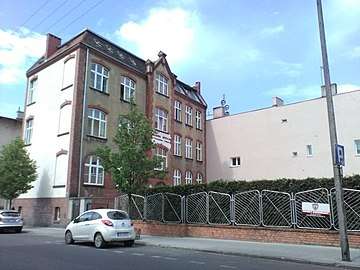 View from Obrońców Bydgoszczy street
View from Obrońców Bydgoszczy street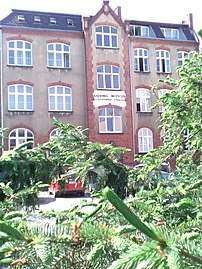 View of the main frontage from Emila Warmińskiego street
View of the main frontage from Emila Warmińskiego street
Julius Holtz tenement at No.2/4
Registered on Kuyavian-Pomeranian Voivodeship heritage list, No.601387 A/850 (April 9, 1996)[10]
1883-1884[5]
The plot covering No.2 and 4 belonged in the early 1880s to Julius Holtz. As a merchant, he had these buildings constructed in 1884 and lived at No.2, then Petersonstraße 15[6]. Later he became a business bank manager and kept ownership of the premises till the outbreak of WWI. In the 1920s, the ensemble was divided into two tenements and was the property of various merchants.
Both houses show symmetrical shapes, based on a vertical axis cutting through the middle bay window, reminiscent of the original aim of the construction as one tenement. Eclectic style is apparent, in particular with balustrades, cartouches filled with motifs, friezes, figure head inside pediments and three characteristic open gables. The middle body displays a large bay window carrying a loggia flanked with columns and pilasters, capped on the upper floor by a round French window decorated with a myriad of elements.
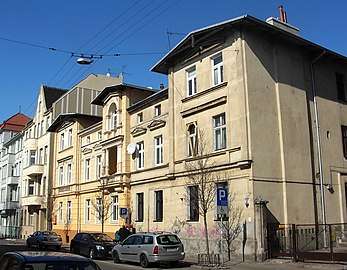 View from the street
View from the street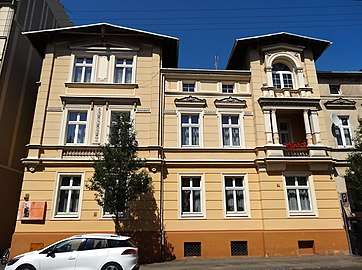 Recently renovated No.4
Recently renovated No.4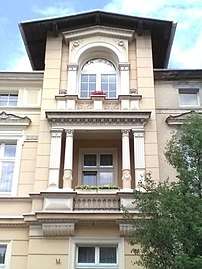 Details of the adorned bay window
Details of the adorned bay window
House at No.3
1883[5]
The building has been one of the first erected in the street in Prussian times, along with No.1. Its first registered landlord was August Remus, an audit inspector in 1885. A few years later, the property became a full board house run by Hedwig Kretschmer[11] during a decade. In 1908, the Congregation of the Sisters of Saint Elizabeth, coming from Wrocław, took possession of the house.[12] The first sisters moved in on December 13, 1921,[13] invited by father Jan Konopczyński. There, they took care of patients and organized kindergarten activities till the start of WWII. After a break under Communist regime, the congregation re-opened a new facility in September 1991, at Stanisława Leszczyńskiego street 40.[13]
The squat house shows eclectic details on its facade, especially around the upper floor openings: adorned pediments topped with strip of friezes and a table corbel.
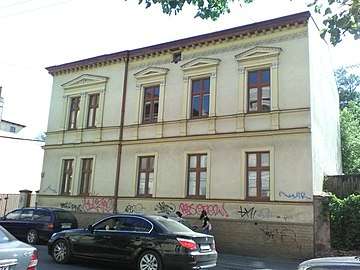 Frontage from the street
Frontage from the street
Friedrich Härzer tenement at No.6
Registered on Kuyavian-Pomeranian Voivodeship heritage list, No.718272 A/1362 (May 15, 2008)[10]
1912[5]
Art Nouveau and Early modernism
The building has been commissioned by Friedrich Härzer, a clothing merchant at Danzigerstraße 45 (today's Gdańska Street No.77).[7]
The edifice's frontage is scattered with cartouches with geometric forms, those on the balcony of the first floor depict mustached faces. The superposition of balconies and bay windows, with their curved shapes and their adorned sleek columns, which are duplicated even at door's level, recalls the Art Nouveau style. However, the rest of the facade does not show a plethora of motifs, as it is usual in Art Nouveau buildings. This absence combined with the feeling of verticality imposed by slender pilasters, narrow openings or the single steep gable reminds of the prelude of the modernism movement.
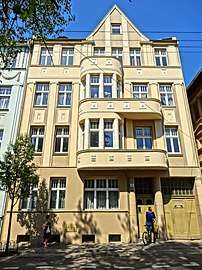 Main elevation from the street
Main elevation from the street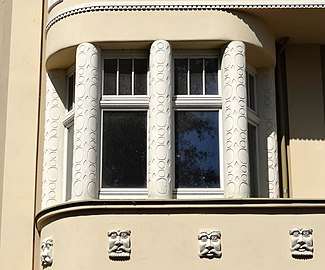 Decoration details
Decoration details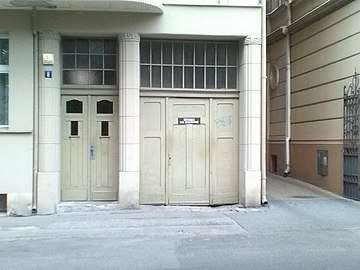 Adorned entrance doors
Adorned entrance doors
Tenement house at No.8
1912[5]
Art Nouveau and Early modernism
The building at then Petersonstraße 12a, has been commissioned by Friedrich Härzer,[7] the clothing merchant who owned also No.6.
The frontage is massive, cut into geometric shapes (bay-windows, balconies, openings), prompting reference to early modernism features, while the decoration (festoons, large cartouches, mustached faces, thin friezes and eyelid dormers) clings to Art Nouveau canons.
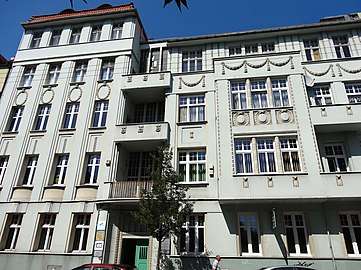 Main elevation
Main elevation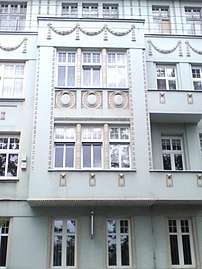 Bay-window decoration
Bay-window decoration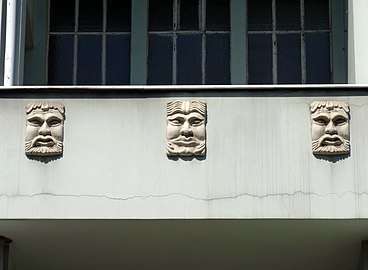 Mustached faces on the balcony
Mustached faces on the balcony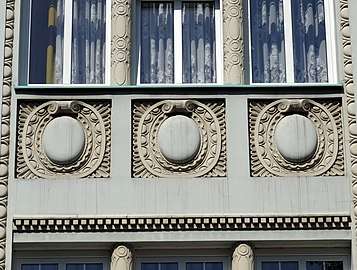 Art Nouveau motifs
Art Nouveau motifs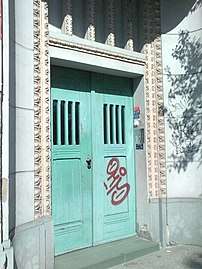 Main door ornamentation
Main door ornamentation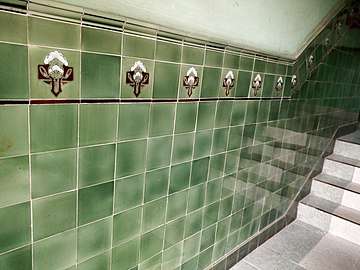 Glazed tiling in the staircase
Glazed tiling in the staircase
Tenement house at No.10
1912[5]
Art Nouveau, elements of Early modernism
The same Friedrich Härzer, landlord of No.6 and 8, was the commissionner of this building registered at the time at Petersonstraße 12.[7]
Compared to the abutting tenements at No.6 or 8, the frontage of No.10 definitely refers to Art Nouveau standards. The arched entrance portal is adorned with the 12 zodiac signs, while above, balconies pile up, adorned with wrought iron railings and geometric motifs. Similarly to No.8, one can notice the presence of a massive bay window with cartouches, pilasters and ornamented lintels. On both sides, many other cartouches brighten up the facade. On the top stand a loggia crowned by a circular roof and a creative curving gable. Be that as it may, the Art Nouveau decoration is balanced by early modernist influence in the presence of geometric shapes everywhere, from the main entrance to the window openings, from the cartouche fillings to the lank rectangular pilasters.
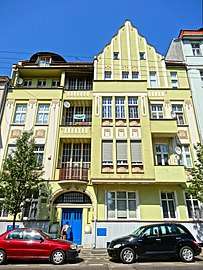 Main frontage
Main frontage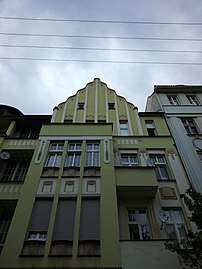 Bay window details
Bay window details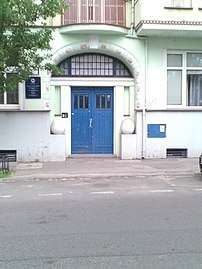 Main portal
Main portal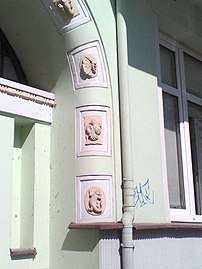 Zodiac signs around the main entrance
Zodiac signs around the main entrance
Mural on tenement at No.11
The gigantic and colorful mural stands on the western wall of the house at No.11. It was created in four days (April 24–28, 2013), during the annual Animocje Festival, Bydgoszcz International Animated Film Festival.[14] The artwork has been realized by Chazme and Sepe, two leading figures of street art in Poland.[15] The mural represents the artists' vision of the Penrose stairs.
It is part of a collection of more than 20 mural works one can appreciate in Bydgoszcz streets.[16]
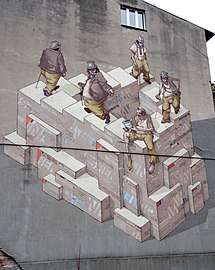 Mural at No.11
Mural at No.11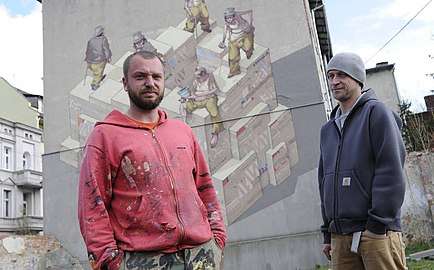 The authors in front of their work
The authors in front of their work
Tenement house at No.12
1893[5]
Mr von ßarnszewski, a merchant not living in Bydgoszcz, was the first owner of this building[17] till the end of the 19th century. Later on, several different landlords came in succession, from the turn of the 20th century to the start of WWI.[7]
Recently refurbished, the frontage boasts eclectic features, with two large balconies and a nicely crafted wood-and-glass entrance door topped by a fan transom light.
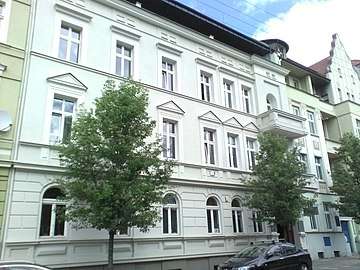 Refurbished facade
Refurbished facade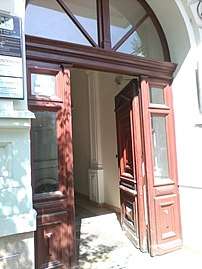 Main entrance door
Main entrance door
Former factory BEFANA at No.13
1852[5]
The site was first a river shipyard, established in 1885 by entrepreneur Leopold Zober,[6] on an area of 0.5 ha, where initially were produced steam boilers and steam locomotives, machines and ship accessories.[18] Taken over by Polish capital, the firm name was changed to Granogsa and Kozłowski (1915), building black tools (spades, axes, pickaxes...) and files, to Bydgoska FAbryka NArzędzi (transl. Bydgoszcz Factory of Files and Tools) in 1923, shortened to BEFANA.[19] Between 1927 and 1939, BEFANA became the biggest file producer in Poland. The company also produced forged tools (hammers, pincer pliers, etc.), in majority to the benefit of the agricultural market.
During World War II the factory's military administration dedicated the production to the army, but no sooner than on February 14, 1945, after the liberation of Bydgoszcz, the factory resumed its regular production. On October 1, 1989, the firm was transformed into a joint venture with foreign capital and changed its name to Befana-Vis, exporting to many European, African and Asian countries as well as American markets. In 2008, new CEO Witold Kaczyński moved the company's headquarters from downtown to a modern production hall in the newly established Bydgoszcz Industrial and Technological Park.[20] The historic site was left abandoned: partly razed, only few buildings still stand today as witness of the feverish industrial age of the place. On May 30, 2019, the city of Bydgoszcz has made known[21] the company in charge of the rewamping of the abandoned lot: AWZ Deweloper[22]. The design will comprise habitation building as well as offices.
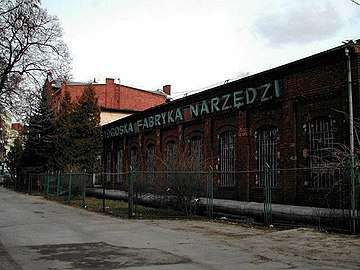 Former factory building ca 2009
Former factory building ca 2009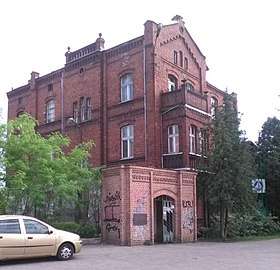 Factory building
Factory building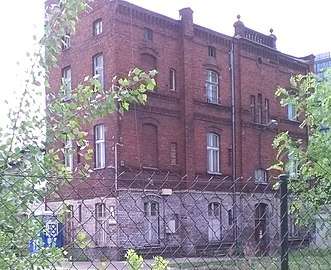 Left building from the street
Left building from the street
Tenement house at No.14
Early 1890s[5]
Mr von ßarnszewski, owner of No.12 (then Petersonstraße 11), also possessed this tenement (Petersonstraße 10).[17] Several different landlords succeeded next, from the start of the 20th century onwards.
Recently refurbished, the frontage displays nice eclectic features:
- balconies with balustrade and stuccoed corbels;
- pedimented windows flanked by pilasters;
- an ornamented motif crowning the facade;
- a table corbel at the top of the elevation;
- an entrance door topped by a fan transom light.
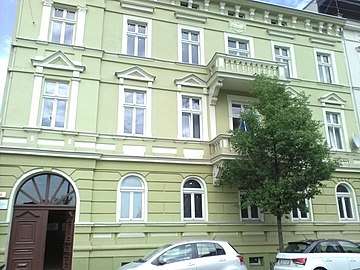 Main frontage
Main frontage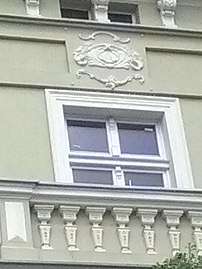 Ornament on top of the facade
Ornament on top of the facade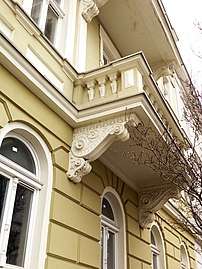 Adorned balcony
Adorned balcony
Tenement house at No.16, corner with Marcinkowskiego street
1875-1900[5]
First known owner was Emil Großmann, a geometer, in 1880.[23] At the time, the building was referenced under the crossing street addressing, then Fischerstraße 6, since Petesonstraße (Obrońców Bydgoszczy street) was only being built. His widow, then his son August kept the ownership of the house till 1900. In the early 1910s, the edifice has been housing a restaurant run by Carl Bartz[7] for several decades. It is still the case today.
Despite a recent renovation, few architectural elements sustained the test of time.
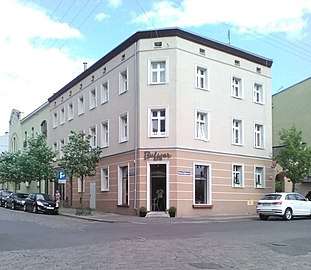 View from the street
View from the street
Bibliography
- Bręczewska-Kulesza, Daria (2004). Nowoczesna dzielnica mieszkaniowa z początku XX w. Kronika Bydgoska T26 (in Polish). Bydgoszcz: Towarzystwo Miłosnikow Miasta Bydgoszczy-Bydgoskie Towarzystwo Naukowe. pp. 69–94.
References
- Adressbuch nebst allgemeinem Geschäfts-Anzeiger von Bromberg und dessen Vororten auf das Jahr 1890 : auf Grund amtlicher und privater Unterlagen. Dittmann. 1890. p. 46.
- Plan der Stadt Bromberg mit Vororten, Druck und Verlag: A. Dittmann, Bromberg
- Wohnungs-Anzeiger nebst Adress- und Geschäfts-Handbuch für Bromberg und Umgebung : auf das Jahr 1884. Mittlersche Buchhandlung (A. Fromm Nachf.). 1884. pp. XXXVI.
- Bydgpszcz, plan miasta, 1947 - Zajazd Miejski Bydgoszczy
- Gminna Ewidencja Zabytków Miasta Bydgoszczy. Program Opieki nad Zabytkami miasta Bydgoszczy na lata 2013-2016
- Wohnungs-Anzeiger nebst Adress- und Geschäfts-Handbuch für Bromberg und Umgebung : auf das Jahr 1885. Bromberg: Mittlersche Buchhandlung (A. Fromm Nachf.). 1885. pp. LXIX, 52.
- Adressbuch nebst Allgemeinem Geschäfts-Anzeiger von Bromberg mit Vororten für das Jahr 1915: auf Grund amtlicher und privater Unterlagen. Bromberg: Dittmann. 1915. pp. 109, 262, 299.
- Książka Adresowa Miasta Bydgoszczy : wydana w roku 1926. Bydgoszcz: Władysław Weber. 1926. pp. 30, 124.
- Czajkowska, Małgorzata (8 January 2017). "Trzy budynki do kupienia. Na mieszkania, usługi, dom starców". bydgoszcz.wyborcza.pl. bydgoszcz.wyborcza. Retrieved 1 September 2018.
- Powiatowy program opieki nad zabytkami Powiatu Bydgoskiego na lata 2013-2016 (PDF). Bydgoszcz: Kujawsko-pomorskie. 1 March 2014.
- Adressbuch nebst allgemeinem Geschäfts-Anzeiger von Bromberg und dessen Vororten auf das Jahr 1897 : auf Grund amtlicher und privater Unterlagen. Bromberg: Dittmann. 1897. p. 285.
- Adressbuch nebst allgemeinem Geschäfts-Anzeiger von Bromberg mit Vorvorten für 1908. Bromberg: Dittmann. 1908. p. 164.
- Jarzembowska, Katarzyna (8 January 2017). "Dla ludzi będących w potrzebie". bydgoszcz.wyborcza.pl. bydgoszcz.wyborcza. Retrieved 1 September 2018.
- Wresiło, Bogumiła (27 April 2013). "Schody donikąd na muralu bydgoskich Animocji". radiopik.pl. radiopik. Retrieved 2 September 2018.
- Narocz, Karol (7 July 2014). "Smakowanie Bydgoszczy (5) - bydgoskie murale... - schody Penrose'a". historiaija.blogspot.com. blogspot. Retrieved 2 September 2018.
- "Murale". visitbydgoszcz.pl. visitbydgoszcz. 2016. Retrieved 2 September 2018.
- Adressbuch nebst allgemeinem Geschäfts-Anzeiger von Bromberg und dessen Vororten auf das Jahr 1895: auf Grund amtlicher und privater Unterlagen. Bromberg: Dittmann. 1895. p. 262.
- Czajkowski, Edmund (1990). Ślady pierwszych stoczni w Bydgoszczy. Kalendarz Bydgoski. Bydgoszcz: Towarzystwo Miłośników Miasta Bydgoszczy. p. 202.
- Błażejewski, Krzysztof (7 May 2017). "Dobrze wypiłowali i gładko oszlifowali swoją światową markę". expressbydgoski.pl. expressbydgoski. Retrieved 3 September 2018.
- "Historia Fabryki BEFANA". befana.com.pl. Befana company. 2018. Retrieved 2 September 2018.
- "Nowy Port-Nowy kawałek miasta". bydgoszczwbudowie.pl. bydgoszczwbudowie. 31 May 2019. Retrieved 8 June 2019.
- "NOWY PORT - Tu będzie biło Serce Bydgoszczy". awz.pl. AWZ Deweloper. 31 May 2019. Retrieved 8 June 2019.
- Adressbuch nebst allgemeinem Geschäfts-Anzeiger von Bromberg und dessen Vororten auf das Jahr 1880: auf Grund amtlicher und privater Unterlagen. Bromberg: Dittmann. 1880. p. 45.
